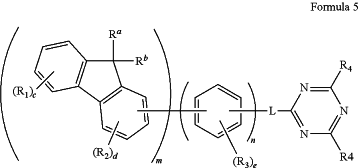| CPC H10K 85/654 (2023.02) [C07D 213/16 (2013.01); C07D 239/26 (2013.01); C07D 251/24 (2013.01); C09K 11/025 (2013.01); C09K 11/06 (2013.01); H10K 50/11 (2023.02); H10K 85/342 (2023.02); H10K 85/615 (2023.02); H10K 85/622 (2023.02); H10K 85/623 (2023.02); H10K 85/624 (2023.02); H10K 85/631 (2023.02); H10K 85/636 (2023.02); H10K 85/6572 (2023.02); C09K 2211/1007 (2013.01); C09K 2211/1011 (2013.01); C09K 2211/1029 (2013.01); C09K 2211/1044 (2013.01); C09K 2211/1059 (2013.01); C09K 2211/185 (2013.01); H10K 50/16 (2023.02); H10K 50/166 (2023.02); H10K 50/171 (2023.02); H10K 50/80 (2023.02); H10K 2101/10 (2023.02); H10K 2101/30 (2023.02); H10K 2101/40 (2023.02)] | 4 Claims |
|
1. An organic electroluminescent element comprising, in the order,
an anode,
a hole injection layer,
a hole transport layer,
a light emitting layer;
an auxiliary electron transport layer;
an electron transport layer;
an electron injection layer; and
a cathode,
wherein the auxiliary electron transport layer, the electron transport layer, and the electron injection layer are different from each other, and
wherein the auxiliary electron transport layer comprises a compound of the following Formula 5:
 wherein,
Ra and Rb are the same or different from each other and are each independently a C1-C40 alkyl group or a C6-C60 aryl group,
R1 and R2 are the same or different from each other and are each independently selected from the group consisting of a hydrogen, a deuterium, a halogen, a cyano group, a nitro group, an amino group, a C1-C40 alkyl group, a C2-C40 alkenyl group, a C2-C40 alkynyl group, a C3-C40 cycloalkyl group, a heterocycloalkyl group having 3 to 40 nuclear atoms, a C6-C60 aryl group, a heteroaryl group having 5 to 60 nuclear atoms, a C1-C40 alkyloxy group, a C6-C60 aryloxy group, a C1-C40 alkylsilyl group, a C6-C60 arylsilyl group, a C1-C40 alkylboron group, a C6-C60 arylboron group, a C1-C40 phosphine group, a C1-C40 phosphine oxide group, and a C6-C60 arylamine group, or adjacent ones of R1 and R2 are optionally respectively to each other to form a fused ring,
R3 is a hydrogen,
L is selected from the group consisting of a single bond, phenylene, and a heteroarylene group having 5 to 18 nuclear atoms,
c and e are each an integer of 0 to 4,
d is an integer of 0 to 3,
m and n are each 1, and
R4 is selected from the group consisting of a hydrogen, a deuterium, a halogen, a cyano group, a nitro group, an amino group, a C1-C40 alkyl group, a C2-C40 alkenyl group, a C2-C40 alkynyl group, a C3-C40 cycloalkyl group, a heterocycloalkyl group having 3 to 40 nuclear atoms, a C6-C60 aryl group, a heteroaryl group having 5 to 60 nuclear atoms, a C1-C40 alkyloxy group, a C6-C60 aryloxy group, a C1-C40 alkylsilyl group, a C6-C60 arylsilyl group, a C1-C40 alkylboron group, a C6-C60 arylboron group, a C1-C40 phosphine group, a C1-C40 phosphine oxide group, and a C6-C60 arylamine group,
wherein the alkyl and aryl groups of Ra and Rb, the alkyl, alkenyl, alkynyl, cycloalkyl, heterocycloalkyl, aryl, heteroaryl, alkyloxy, aryloxy, alkylsilyl, arylsilyl, alkylboron, arylboron, phosphine, phosphine oxide, and arylamine groups of R1, R2, and R4 are optionally each independently unsubstituted or substituted with one or more substituents selected from the group consisting of a deuterium, a halogen, a cyano group, a nitro group, an amino group, a C1-C40 alkyl group, a C2-C40 alkenyl group, a C2-C40 alkynyl group, a C3-C40 cycloalkyl group, a heterocycloalkyl group having 3 to 40 nuclear atoms, a C6-C60 aryl group, a heteroaryl group having 5 to 60 nuclear atoms, a C1-C40 alkyloxy group, a C6-C60 aryloxy group, a C1-C40 alkylsilyl group, a C6-C60 arylsilyl group, a C1-C40 alkylboron group, a C6-C60 arylboron group, a C1-C40 phosphine group, a C1-C40 phosphine oxide group, and a C6-C60 arylamine group, provided that when the substituents are present in a plural number, the substituents are the same or different from each other,
with the proviso that compound of the following formula is excluded:
 |